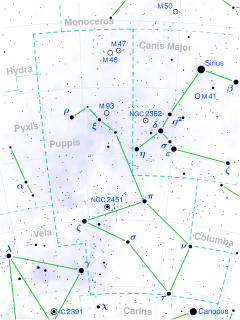Xi Puppis
| Observation data Epoch J2000 Equinox J2000 | |
|---|---|
| Constellation | Puppis |
| Right ascension | 07h 49m 17.65567s[1] |
| Declination | −24° 51′ 35.2305″[1] |
| Apparent magnitude (V) | 3.35[2] |
| Characteristics | |
| Spectral type | G6 Iab-Ib[3] |
| U−B color index | +1.18[2] |
| B−V color index | +1.25[2] |
| Astrometry | |
| Radial velocity (Rv) | +2.7[4] km/s |
| Proper motion ( | RA: −4.81[1] mas/yr Dec.: −0.89[1] mas/yr |
| Parallax ( | 2.72 ± 0.21 mas[1] |
| Distance | 1,200 ± 90 ly (370 ± 30 pc) |
| Absolute magnitude (MV) | –3.89[5] |
| Details | |
| Mass | 9.9 ± 1.0[3] M☉ |
| Radius | 116[6][a] R☉ |
| Luminosity | 7,080[6] L☉ |
| Surface gravity (log g) | 1.19[5] cgs |
| Temperature | 4,880 ± 150;[3] 4,925[5] K |
| Metallicity [Fe/H] | +0.13[5] dex |
| Rotational velocity (v sin i) | 9.2[7] km/s |
| Age | 23[3] Myr |
| Other designations | |
| Database references | |
| SIMBAD | data |
Xi Puppis (
The system consists of a spectroscopic binary, designated Xi Puppis A,[8] together with a third companion star, Xi Puppis B. A's two components are themselves designated Xi Puppis Aa (formally named Azmidi /ˈæzmɪdi/)[9] and Ab.
Nomenclature[edit]
The system was sometimes known as Asmidiske (Azmidiske), a misspelling and misplacement of Aspidiske (from the Greek for 'little shield), the traditional name of Iota Carinae.[11] In 2016, the I
Properties[edit]
Because of the distance of this system from the Earth, its visual magnitude is reduced by 0.73 as a result of extinction from the intervening gas and dust.[14]
Xi Puppis A presents as a yellow supergiant of spectral class G6 with a luminosity 8,300 times that of the Sun.[11]
The 13th-magnitude companion, Xi Puppis B, is about 5 arcseconds distant and is a Sun-like star that orbits at least 2000
Notes[edit]
- ^ Calculated using a luminosity of 7,080 L☉ and temperature of 4,917 K.
References[edit]
- ^ a b c d e f van Leeuwen, F. (November 2007), "Validation of the new Hipparcos reduction", Astronomy and Astrophysics, 474 (2): 653–664, arXiv:0708.1752, Bibcode:2007A&A...474..653V, doi:10.1051/0004-6361:20078357, S2CID 18759600
- ^ a b c d Johnson, H. L.; et al. (1966), "UBVRIJKL photometry of the bright stars", Communications of the Lunar and Planetary Laboratory, 4 (99): 99, Bibcode:1966CoLPL...4...99J
- ^ a b c d Lyubimkov, Leonid S.; et al. (February 2010), "Accurate fundamental parameters for A-, F- and G-type Supergiants in the solar neighbourhood", Monthly Notices of the Royal Astronomical Society, 402 (2): 1369–1379, arXiv:0911.1335, Bibcode:2010MNRAS.402.1369L, doi:10.1111/j.1365-2966.2009.15979.x, S2CID 119096173
- ^ Wilson, R. E. (1953). "General Catalogue of Stellar Radial Velocities". Carnegie Institute Washington D.C. Publication. Carnegie Institute of Washington D.C. Bibcode:1953GCRV..C......0W.
- ^ a b c d Luck, R. Earle (2014-06-01). "Parameters and Abundances in Luminous Stars". The Astronomical Journal. 147: 137. doi:10.1088/0004-6256/147/6/137. ISSN 0004-6256. Xi Puppis' database entry at VizieR.
- ^ a b McDonald, I.; Zijlstra, A. A.; Boyer, M. L. (2012-11-01). "Fundamental parameters and infrared excesses of Hipparcos stars". Monthly Notices of the Royal Astronomical Society. 427: 343–357. arXiv:1208.2037. doi:10.1111/j.1365-2966.2012.21873.x. ISSN 0035-8711. Xi Puppis' database entry at VizieR.
- ^ De Medeiros, J. R.; Udry, S.; Burki, G.; Mayor, M. (2002). "A catalog of rotational and radial velocities for evolved stars. II. Ib supergiant stars". Astronomy and Astrophysics. 395: 97–98. arXiv:1312.3474. Bibcode:2002A&A...395...97D. doi:10.1051/0004-6361:20021214.
- ^ "Washington Double Star Catalog". United States Naval Observatory. Retrieved 20 June 2018.
- ^ a b "Naming Stars". IAU.org. Retrieved 18 June 2018.
- ^ Hessman, F. V.; Dhillon, V. S.; Winget, D. E.; Schreiber, M. R.; Horne, K.; Marsh, T. R.; Guenther, E.; Schwope, A.; Heber, U. (2010). "On the naming convention used for multiple star systems and extrasolar planets". arXiv:1012.0707 [astro-ph.SR].
- ^ a b c Kaler, James B., "ASMIDISKE (Xi Puppis)", Stars, University of Illinois, retrieved 2018-06-20
- ^ "I
AU Working Group on Star Names (WGSN)". Retrieved 22 May 2016. - ^ "WG Triennial Report (2015-2018) - Star Names" (PDF). p. 5. Retrieved 2018-07-14.
- ^ Luck, R. E. (May 1, 1982), "The chemical composition of late-type supergiants. IV - Homogeneous abundances and galactic metallicity trends", Astrophysical Journal, Part 1, 256: 177–188, Bibcode:1982ApJ...256..177L, doi:10.1086/159895

